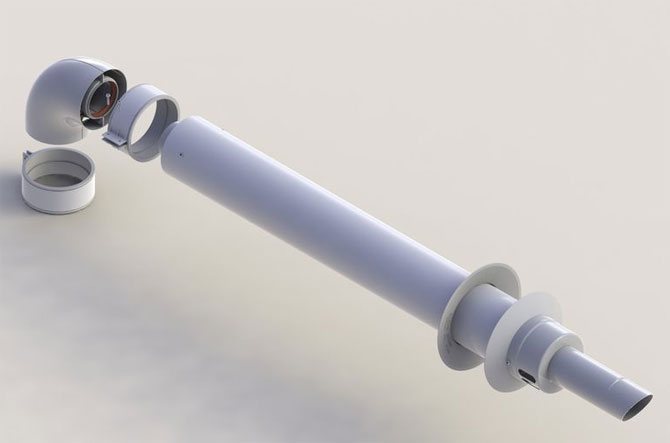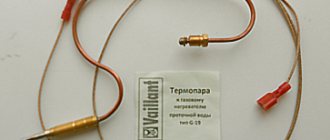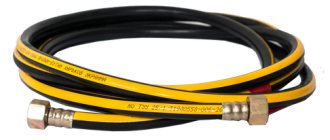According to the official opinion of the Ministry of Natural Resources and Environment of the Russian Federation, in 2034 gas will be the main raw material for the energy sector. In this regard, the main task is to develop the extraction of this resource, as well as gasification of our homes. In the southern regions of our country, two types of energy have been used in parallel for a long time - electric and gas. This option is convenient and practical, especially in a private house. Whether you need gas equipment in your home is up to you.
Knowing that gas will perfectly be able to insure in case of interruptions in electricity, hot water, heating in an apartment, the choice is obvious. The only condition for the safe operation of gas equipment is the fulfillment of all regulatory rules, starting with the installation of the system.
How is the selection and design of chimneys regulated
Depending on your needs, you choose the right gas equipment, it can be:
- Gas boiler for home heating.
- Gas water heater.
- Gas stove for cooking.
Below we will take a closer look at the types of ventilation ducts suitable for gas equipment, and everything you need to know about built-in hoods. And also the installation of a smoke exhaust system, safe in operation, meeting the requirements of SanPin and fire inspection:
- SanPiN 2.2.4.548-96
- SanPiN 2.1.2.2645-10
- SP 89.13330.2012
- PPR instruction paragraph 2 chapter 1 of 2020
End platform (wall plate) for gas water heaters
| ✓ In stock for today,: Shop / office: More details The end platform is designed to connect the gas column duct to the ventilation duct in the wall. Easy installation with self-tapping screws. | The size | Wholesale | Retail price |
| End platform Ø100 | 149 | 200 rbl | |
| End platform Ø110 | 157 | 200 rbl | |
| End platform Ø120 | 165 | 200 rbl | |
| End platform Ø125 | 201 | 201 rbl | |
| End platform Ø130 | 172 | 201 rbl | |
| End platform Ø140 | 179 | 220 rbl | |
| End platform Ø150 | 188 | 220 rbl |
Features of the chimney device
The ventilation system for removing waste products of combustion and ensuring the flow of air in the room has the same device, whether it is an exhaust from a corrugation for a gas water heater or a solid brick chimney. The chimney must consist of the following parts:
- Lead-through pipe.
- Combustion products discharge pipe.
- Adapter for connecting the previous parts to each other.
- Clamps and mounting brackets.
- Telescopic tubes.
- T-piece with a condensate drainage hole.
- Taps.
- Tapered tip.
All parts can be connected one by one independently, without violating safety precautions, using special non-combustible materials. But it is better to turn to professionals.
What is the difference between chimneys after all? The material from which the parts are made, the choice of the pipe installation method and the geometry of the ventilation shafts.
Gas flange for gas water heaters
| ✓ In stock for today,: Shop / office: More details The gas flange is installed on the opening of the ventilation shaft and is designed to connect the gas column chimney to it. It is also used to organize a cleaning pocket (ash pan) together with a plug. | The size | Wholesale | Retail price |
| Flange Ø110 mm | 230 | 308 rbl | |
| Flange Ø120 mm | 242 | 308 rbl | |
| Flange Ø130 mm | 254 | 308 rbl |
Chimney from galvanized pipe
At the stage of designing ventilation for a gas column, choosing a material, opt for a galvanized pipe. Taking into account the heating temperature when disposing of combustion products from the room, the wall thickness is selected equal to 0.5 millimeters at a heating temperature of 400 °.
When choosing pipes for a gas column, the configuration of the future hood is taken into account - single-circuit or double-circuit.
In the second case, the pipe is applicable for sandwich and coaxial chimneys.
They differ in that in the sandwich system, basalt wool is laid between the two pipes, in the coaxial chimney, on the contrary, air circulates. Due to its properties and ease of installation of a hood for a gas water heater, chimney sandwiches are popular today.

Exhaust bends for gas columns (elbow)
| 45 degree elbow (knee) ✓ In stock for today,: Shop / office: | The size | Wholesale | Retail price |
| Diversion Ø100 45 ° | 405 | 520 rbl | |
| Diversion Ø110 45 ° | 429 | 545 rbl | |
| Diversion Ø120 45 ° | 448 | 566 rbl | |
| Diversion Ø125 45 ° | 520 | 572 rbl | |
| Diversion Ø130 45 ° | 472 | 594 rbl | |
| Diversion Ø140 45 ° | 490 | 626 rbl | |
| Diversion Ø150 45 ° | 508 | 650 rbl | |
| Diversion Ø160 45 ° | 531 | 726 rbl | |
| 90 degree elbow (knee) ✓ In stock for today,: Shop / office: | Diversion Ø100 90 ° | 429 | 544 rbl |
| Diversion Ø110 90 ° | 451 | 572 rbl | |
| Diversion Ø120 90 ° | 472 | 603 rbl | |
| Diversion Ø125 90 ° | 612 | 612 rbl | |
| Diversion Ø130 90 ° | 496 | 630 rbl | |
| Diversion Ø140 90 ° | 514 | 660 rbl | |
| Diversion Ø150 90 ° | 538 | 686 rbl | |
| Diversion Ø160 90 ° | 506 | 695 rbl |
Coaxial chimney for gas boiler
As mentioned above, a coaxial chimney is a double-circuit pipe. Its principle of operation is based on the inflow of clean air masses through the distance between the pipes, and the output of carbon monoxide through the inner pipe. The use of a coaxial hood for gas water heaters in an apartment will help bypass the public ventilation duct, removing the combustion products through the pipe to the street, and avoid a situation with a loss of boiler efficiency, which may occur if the ventilation duct is clogged.
It is important to know that when installing a closed-type gas boiler, only a coaxial chimney is installed.
This system uses a pipe with a diameter of 11 centimeters. Fans with sensors are often installed for greater thrust. This allows you to achieve high performance of the gas boiler at any time of the year.


Plug for cleaning the ash pan of the gas water heater
| ✓ In stock for today,: Shop / office: More details Plug for cleaning the ventilation duct to which the gas water heater is connected. Flange not included. | The size | Wholesale | Retail price |
| Plug Ø110 mm | 278 | 352 rbl | |
| Plug Ø120 mm | 290 | 352 rbl | |
| Plug Ø130 mm | 302 | 352 rbl |
Ceramic chimney
When using a ceramic flue gas vent, it should be understood that ceramic has a high moisture absorption rate. To increase its service life, additional exhaust ducts must be installed.
When installing the exhaust system, the ceramic pipe is wrapped in insulation and installed in an expanded clay or brick box.
It should be noted that this method of exhaust gas removal is expensive. And it is not suitable for the gas water heater in the apartment.
We recommend that you familiarize yourself with: Ventilation diffuser: types and features


Requirements for a smoke exhaust structure
The basic rules of SNiP 42-01-2002 and 2.04.08-87 approved the following requirements for the installation of gas boilers and their connection to the hood:
- The ceiling in the boiler room must be at least 2.5 meters high.
- The area of the premises for one piece of equipment must be at least 4 square meters.
- It is obligatory to have a window with a window with an area of at least 0.3 square meters. Otherwise, additional ventilation is required.
- The walls in the boiler room must be made of non-combustible materials.
- An inspection window must be located in the chimney system, such a device is installed at a distance of 0.25 meters from the chimney hole.
- Several gas powered appliances must not be connected to the same ventilation.
- The gas stove must be located in another room, separate from the boiler at a distance of at least 6 meters. If these conditions are met, it becomes possible to cancel the previous comment.


Gas water heater adapters
| ✓ In stock for today,: Shop / office: More details Purpose: for changing from one diameter to another | The size | Wholesale | Retail price |
| Transition Ø80x100 | 462 | 521 rbl | |
| Transition Ø100x120 | 478 | 537 rbl | |
| Transition Ø100x125 | 498 | 583 rbl | |
| Transition Ø110x130 | 522 | 612 rbl | |
| Transition Ø120x130 | 562 | 632 rbl | |
| Transition Ø120x150 | 605 | 638 rbl | |
| Transition Ø125x150 | 616 | 650 rbl | |
| Transition Ø125x160 | 645 | 670 rbl | |
| Transition Ø130x150 | 637 | 660 rbl | |
| Transition Ø150x160 | 677 | 718 rbl | |
| Transition Ø150x200 | 720 | 766 rbl | |
| Transition Ø160x200 | 824 | 835 rbl | |
| Transition Ø200x250 | 872 | 938 rbl |
Step-by-step instructions for the construction of a smoke exhaust system
To commission the equipment, the ventilation of the room must be taken into account. In the absence of air exchange, a forced turbo exhaust is required. Without it, putting the gas boiler into operation is impossible. We will consider how a gas boiler hood is installed in a private house using the example of a coaxial chimney. The length of the pipe from the boiler room to the street for this type of hood is not more than two meters.
- Before starting work, make sure that the installation of the gas boiler is in accordance with the rules and regulations approved by the inspection organizations in order to avoid reworking the entire power unit.
- Select a suitable material for the hood, taking into account the parameters of the flue gas outlet: gas boiler inlet = pipe diameter.
- Calculating the power of the fans and their number, taking into account how long the hood is, the number of elbows in its structure, and the position in space relative to the horizon, at what height the chimney is located in the room.
- Do not forget about the features of budget technology, indicated in the data sheet.
- All materials used in the work must be fireproof and not corrosive.
- After making sure of the integrity of all parts, we proceed to the assembly. We attach the chimney elbow to the gas boiler pipe using a tee.
- To build up a coaxial pipe and connect all its parts, special crimping clamps and refractory sealants are used.
- Turbo exhaust is used when there are more than two elbows in the pipeline geometry. This helps to maintain the efficiency of the gas boiler.. The fan and all sensors are installed after installing the supply pipe.
- Mounting a coaxial pipe outside a building is no different from mounting a conventional chimney sandwich.
We recommend that you familiarize yourself with: How to install a metal corrugation on a hood in the kitchen


Outside the building
Having laid the line for the exhaust device in the house, the design of the exhaust for the gas boiler goes out into the street.
- As soon as the pipe has been brought out into the street through the hole in the wall, it must be closed with special metal plates. The remaining space between the pipe and the wall is filled with mineral wool.
- Now we install the tee. The bottom hole is closed with a plug with a revision for cleaning the pipe.
- We build up the chimney to the required length by connecting the parts with the help of special sealant and clamps with gaskets. As the pipe grows, we attach it to special brackets.
- We install a protective cone at the top of the chimney and additionally fasten it to the braces in those places.
- If the structure of the chimney was not covered with special paint in production, this can be done at home. This is done to protect the metal from environmental influences.
When ordering an outdoor chimney system, it is important to consider where the forced exhaust starts from the gas boiler or from the room where the turbo elements are installed.
You can see how to connect a gas water heater to the chimney system and how to assemble it in the video.


Inside the house
Inside the house, the installation of a coaxial chimney, in detail, with comments, was described above. The only step left for you to take is to connect the two pipes, street and room, by extension. For additional insulation, it is recommended to use special metal tape.
I would like to note an important advantage of a coaxial chimney - it is the absence of additional holes in the roof or wall of your home.


Clamp for fastening the pipe of the gas water heater to the wall
| ✓ In stock for today,: Shop / office: Used to fix a long chimney to the wall. Clamps reliably crimp the chimney and have fasteners for a standard M8 stud | The size | Retail price |
| Clamp Ø110 mm | 110 rbl | |
| Clamp Ø120 mm | 120 rbl | |
| Clamp Ø125 mm | 120 rbl | |
| Clamp Ø130 mm | 120 rbl |
Insulation of the smoke exhaust structure
A gas pipe is often the cause of a fire. After checking the pipeline structure by the gas service for defects and microcracks, they must be immediately eliminated. Taking into account the rules of SNiP for the installation of gas equipment, it is necessary to use heat-insulating materials at the points of contact between the pipe and the frame of the house. Such as basalt, mineral wool, fire-resistant mastic will protect you from fire. It is very important not to ignore the recommendations of experts when choosing insulating materials for a built-in hood.
A poorly insulated hood from a gas boiler in a private house or apartment is harmful to health, not good. So do not save on your health, turn to specialists for help so that the gas water heater in the kitchen and other equipment will serve for a long time and properly.
Gas Column Air Duct Connectors
| ✓ In stock for today,: Shop / office: More details The chimney nipple of the gas water heater is used to connect the pipe with the end part to the tee, transition, and also as a starting element on rare models of gas water heaters | The size | Opt. | Retail price |
| Nipple Ø80 mm | 105 | 105 rbl | |
| Nipple Ø100 mm | 105 | 105 rbl | |
| Nipple Ø110 mm | 105 | 105 rbl | |
| Nipple Ø120 mm | 105 | 105 rbl | |
| Nipple Ø125 mm | 105 | 105 rbl | |
| Nipple Ø130 mm | 105 | 105 rbl | |
| Nipple Ø140 mm | 105 | 105 rbl | |
| Nipple Ø150 mm | 105 | 105 rbl | |
| Nipple Ø160 mm | 105 | 105 rbl |






































